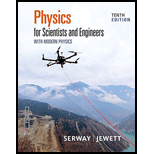
Concept explainers
In a laboratory frame of reference, an observer notes that Newton’s second law is valid. Assume forces and masses are measured to be the same in any reference frame for speeds small compared with the
(a)
To show: The Newton’s second law is valid for an observer moving at a constant speed of light, relative to the laboratory frame.
Answer to Problem 1P
The Newton’s second law is valid for an observer moving at a constant speed of light, relative to the laboratory frame.
Explanation of Solution
Assume
The Galilean coordinate transformation is,
To find the velocity, take a time derivative
Substitute
To find the acceleration, take another time derivative
Substitute
It is shown from the above equation that the accelerations are identical.
The Newton’s second law is the same.
Thus, the Newton’s second law is valid for an observer moving at a constant speed of light, relative to the laboratory frame.
Conclusion:
Therefore, the Newton’s second law is valid for an observer moving at a constant speed of light, relative to the laboratory frame.
(b)
The Newton’s second law is not valid in a reference frame moving past the laboratory frame with a constant acceleration.
Answer to Problem 1P
The Newton’s second law is not valid in a reference frame moving past the laboratory frame with a constant acceleration.
Explanation of Solution
Assume
The Galilean coordinate transformation is,
To find the velocity, take a time derivative
Substitute
To find the acceleration, take another time derivative
Substitute
It is shown from the above equation that the accelerations are not identical.
The Newton’s second does not have same value in two different frames,
Substitute
Conclusion:
Therefore, Newton’s second law is not valid in a reference frame moving past the laboratory frame with a constant acceleration.
Want to see more full solutions like this?
Chapter 38 Solutions
Physics for Scientists and Engineers with Modern Physics
- A block of mass m = 3.00 kg situated on a rough incline at an angle of 0 = 37.0° is connected to a spring of negligible mass having a spring constant of 100 N/m (see the figure below). The pulley is frictionelss. The block is released from rest when the spring is unstretched. The block moves 11.0 cm down the incline before coming to rest. Find the coefficient of kinetic friction between block and incline. k=100 N/m Ө marrow_forward23. What is the velocity of a beam of electrons that goes undeflected when passing through perpendicular electric and magnetic fields of magnitude 8.8 X 103 V/m and 7.5 X 10-3 T. respectively? What is the radius of the electron orbit if the electric field is turned off?arrow_forward10. A light bulb emits 25.00 W of power as visible light. What are the average electric and magnetic fields from the light at a distance of 2.0 m?arrow_forward
- 9. Some 1800 years ago Roman soldiers effectively used slings as deadly weapons. The length of these slings averaged about 81 cm and the lead shot that they used weighed about 30 grams. If in the wind up to a release, the shot rotated around the Roman slinger with a period of .15 seconds. Find the maximum acceleration of the shot before being released in m/s^2 and report it to two significant figures.arrow_forwardIn the movie Fast X, a 10100 kg round bomb is set rolling in Rome. The bomb gets up to 17.6 m/s. To try to stop the bomb, the protagonist Dom swings the counterweight of a crane, which has a mass of 354000 kg into the bomb at 3.61 m/s in the opposite direction. Directly after the collision the crane counterweight continues in the same direction it was going at 2.13 m/s. What is the velocity (magnitude and direction) of the bomb right after the collision?arrow_forwardDon't use aiarrow_forward
- Make sure to draw a sketch with scale as wellarrow_forwardMake sure to draw a sketch with scalearrow_forwardUltimate Byleth and Little Mac fight. Little Mac, who is a boxer, dashes forward at 26.6 m/s, fist first. Byleth moves in the opposite direction at 3.79 m/s, where they collide with Little Mac’s fist. After the punch Byleth flies backwards at 11.1 m/s. How fast, and in what direction, is Little Mac now moving? Little Mac has a mass of 48.5 kg and Byleth has a mass of 72.0 kg.arrow_forward
 Modern PhysicsPhysicsISBN:9781111794378Author:Raymond A. Serway, Clement J. Moses, Curt A. MoyerPublisher:Cengage Learning
Modern PhysicsPhysicsISBN:9781111794378Author:Raymond A. Serway, Clement J. Moses, Curt A. MoyerPublisher:Cengage Learning Principles of Physics: A Calculus-Based TextPhysicsISBN:9781133104261Author:Raymond A. Serway, John W. JewettPublisher:Cengage Learning
Principles of Physics: A Calculus-Based TextPhysicsISBN:9781133104261Author:Raymond A. Serway, John W. JewettPublisher:Cengage Learning Physics for Scientists and Engineers: Foundations...PhysicsISBN:9781133939146Author:Katz, Debora M.Publisher:Cengage Learning
Physics for Scientists and Engineers: Foundations...PhysicsISBN:9781133939146Author:Katz, Debora M.Publisher:Cengage Learning Classical Dynamics of Particles and SystemsPhysicsISBN:9780534408961Author:Stephen T. Thornton, Jerry B. MarionPublisher:Cengage Learning
Classical Dynamics of Particles and SystemsPhysicsISBN:9780534408961Author:Stephen T. Thornton, Jerry B. MarionPublisher:Cengage Learning University Physics Volume 3PhysicsISBN:9781938168185Author:William Moebs, Jeff SannyPublisher:OpenStax
University Physics Volume 3PhysicsISBN:9781938168185Author:William Moebs, Jeff SannyPublisher:OpenStax Physics for Scientists and Engineers, Technology ...PhysicsISBN:9781305116399Author:Raymond A. Serway, John W. JewettPublisher:Cengage Learning
Physics for Scientists and Engineers, Technology ...PhysicsISBN:9781305116399Author:Raymond A. Serway, John W. JewettPublisher:Cengage Learning





